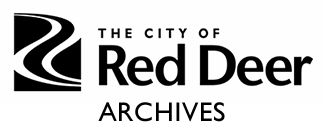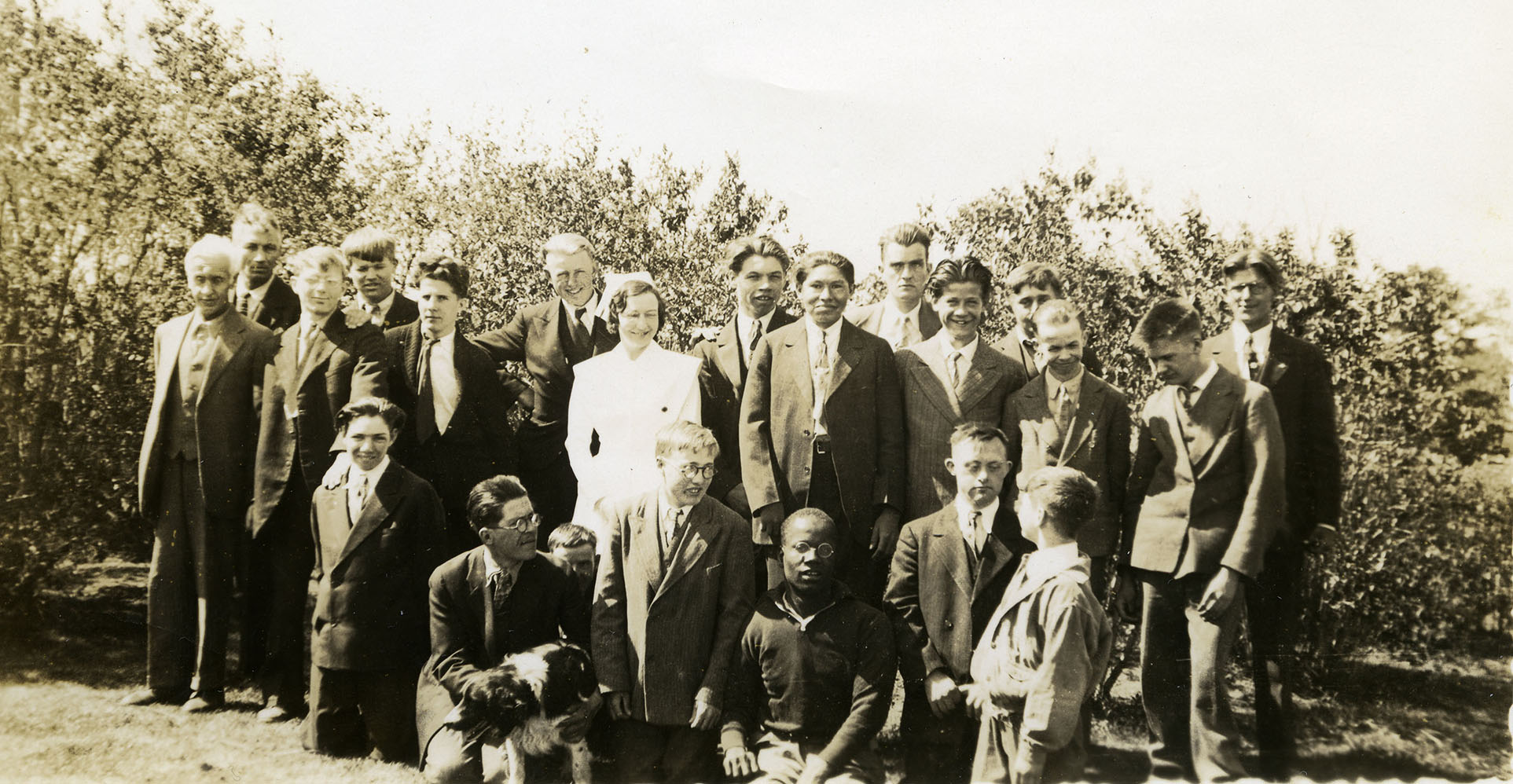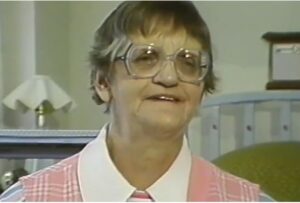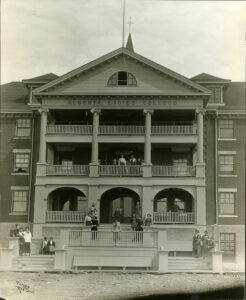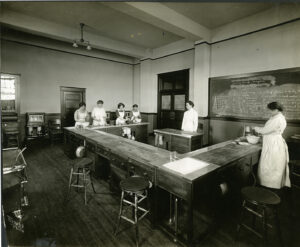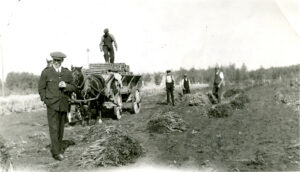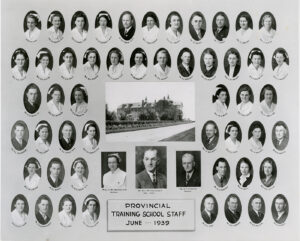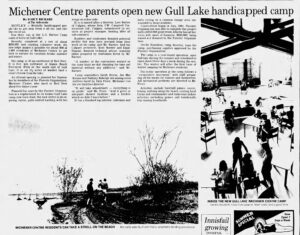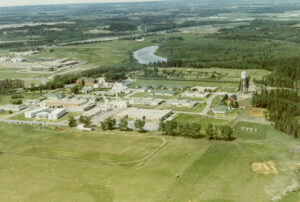Michener Centre
Overlooking the city of Red Deer from its eastern hilltop vantage point, Michener Centre’s legacy in central Alberta cannot be understated. At one time employing one of every five city residents, it served as a central figure in Red Deer’s economy. More important is its impact on the thousands of residents it housed, which overshadows the rest of its long history.
*Content Warning: Forced & Coerced Sterilization*
The contents on this page reference forced and coerced sterilization. The people who lived at Michener Centre have been referred to in records as residents, patients, and inmates. We chose to use the word residents to emphasize that this was often the only home many people at Michener had and each person’s situation and experience was unique including the treatment they received. We believe resident stories are best told first hand. The archival records of Doreen Befus, and published works by other former residents are available at the Red Deer Archives.
Disability activist Doreen Befus, a former resident of Michener Centre, and sterilization survivor speaks to her experience.
Alberta Ladies College (1913-1916)
Opened in 1913 as a boarding school for the education of girls and young women, the Alberta Ladies College occupied thirty acres of land within the city limits to the east. The primary building was massive, featuring four storeys of steel and pressed brick with stone facings. This building was heated with steam, lit with electricity, and able to accommodate eighty students in residence.
The college was dedicated to the cause of Christian education, founded under the auspices of the Presbyterian Church, but was non-sectarian and non-denominational in instruction. The students were taught the public high school curriculum with additional courses in music (such as piano, voice, and violin), domestic science and art, commercial skills (including typewriting, stenography, and shorthand), fine art, and school of expression and physical culture. The school’s first Lady Principal was Mrs. J. Muldrew and the first President was Rev. N.D. Keith. Fees for 1913 were $340 per annum for board, residence, and tuition, excluding the additional subjects.
The college held the property until July 1, 1916, when outstanding debt including $63,500 in unpaid subscriptions resulted in the sale of the building to the provincial government for $125,000. Classes were moved temporarily to the University of Alberta in Edmonton and later became the Westminster Ladies’ College.
Soldiers’ Hospital (1918-1923)
After the province acquired the site in 1916 it sat empty until March 1918. By this time, it was clear that some of the soldiers returning from the First World War were suffering from shell shock and other mental health conditions. A need for a psychiatric hospital was identified, and this site was selected. In 1923 the province decided to move these soldiers to the Ponoka and Oliver (Edmonton) institutes and turn the Red Deer facility into a home for “mentally defective children” named the Provincial Training School.
Also known as the Soldiers’ Hospital, Soldiers’ Convalescence Home, the Soldiers’ Mental Hospital, Returned Soldiers’ Hospital, Mental Hospital for Returned Soldiers, Soldiers’ Sanitorium (Sanitarium).
Eugenics
There is both an indirect and direct relationship between institutionalization and eugenics. Eugenicists believe that many “undesirable” characteristics are hereditary, including intellectual disability, mental illness, alcoholism, poverty, criminality, and various types of “immoral” behaviour, including prostitution. Institutionalization itself functioned as a form of segregation, limiting one’s capacity to reproduce.
In Alberta, the connection goes deeper. The Sexual Sterilization Act was enacted in Alberta on March 21, 1928, and remained in place until 1972. It was the first eugenics sterilization law in Canada. Between 1928 and 1972 the Alberta government sterilized 2844 people, including many people who were institutionalized or attempting to leave institutions. Although it has been stated that the surgeries took place in various locations in Alberta, many of the victims were Michener Centre residents such as Leilani Muir who later won litigation against the Province of Alberta for her forced sterilization at the age of fifteen. Her success opened the door to financial settlements for over 700 hundred other survivors.
Provincial Training School – PTS (1923-1964)
The Provincial Training School opened October 1923 under the First Medical Superintendent Dr. McAlister (1923-1931). Initially the institute’s resident population was made up of children with varying levels of physical and mental disabilities. Some of their disabilities were incredibly severe and others would be considered learning or behavioural disorders today. Along with housing the residents, programming emphasis changed over time, with an initial focus on farm training and recreational activities and later evolving in the 1950s to focus on education for the higher functioning residents with academics, sense training, occupational therapy, vocational training, and recreational training.
People became institutionalized after recommendations from family, apprehensions by police or government officials, or upon referral from doctors or psychiatrists. Long wait lists for placement and issues of overcrowding at the institute made expansion continuous throughout the decades. With the purchase of the 420-acre J.J. Gaetz farm northeast of the PTS in 1939, many of the older male residents provided unpaid labour farming the land and provided abundant produce for the facility and community.
By the early 1960s, social opinion about long-stay institutions began to shift, and for Red Deer that brought more community involvement and integration along with changes to the established Mental Deficiency Nursing program.
Alberta Mental Deficiency Nurses’ Association (1935-1973)
The Provincial Training School of Nursing developed a three-year program to train nurses providing hands on experience with the residents of the institute. The program granted 453 graduates Mental Deficiency Nurse status from 1935 to 1973. At the time, this was the only school of nursing in Canada to offer specialized education in care and training for the mentally disabled.
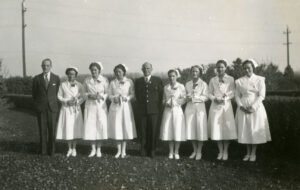
First graduating class, Provincial Training School, between 1935 and 1937. Red Deer Archives, P12060 (cropped.)
Parent Organization (1956-Present)
The Parent-School Association for Exceptional Children was formed in 1956, with approximately 200 members initially. Their first project raised funds for the purchase of televisions for PTS residences. Later called the Parent Organization Michener Centre and then Society of Parents & Friends of Michener Centre, the group supported numerous impactful projects, such as funding the building of the curling rink, the “Centennial railroad”, the L.G. Barnes Camp at Gull Lake, and the first group home, called The West Park House.
Deerhome (1957-1976)
In 1957, Deerhome Institute, a separate provincially run institution for adults with mental disabilities, opened a half mile northeast of the original PTS. The site initially consisted of three dormitories, a utilities building, and a kitchen. With an increase in the resident population, it grew to include eight dormitory buildings, a recreation hall, two nurse’s residences, an administration building, and various structural housing support services. The First Chief Administrator for Deerhome was Dr. Randall R. McLean.
Alberta School Hospital – ASH (1965-1976)
In 1965, PTS was renamed Alberta School Hospital (ASH). Along with providing housing and care for the residents, the ASH focused on academics, farming, vocational training, occupational therapy, and recreational activities. To match growing needs, the institute physically expanded over the years to include more staff accommodations and dormitories, a schoolhouse, a powerhouse, a fire hall, expansive root cellars, a greenhouse, a laundry, an infirmary, a clinical building, and a Superintendent’s home. The Michener Hill curling rink was built in 1964 by the vocational staff and students. In 1985 the Michener Hill Curling Club began leasing it from the provincial government and it continues to be used by the Club today.
The administration of ASH and Deerhome amalgamated in 1973, however, the two institutions were still referred to with separate names until 1977 when they were renamed to Michener Centre.
Michener Centre (1977 – present)
Michener Centre was named for prominent central Albertan and then-current Governor General of Canada, The Right Honorable Roland Michener. Along with the name change came the new public Roland Michener Recreation Centre which included a swimming pool, diving pool, therapeutic pool, gymnasium, theatre, racquetball court, sauna, and weight room. The Deerhome site was now referred to as “Michener north” and the original site as “Michener south”. By 1983, Michener Centre had expanded to become a 66-building complex covering 360 acres.
Changes to the buildings and programs throughout the years reflected changing ideas on segregation versus integration for mentally and physically disabled people. Practices shifted from eugenics and segregation to multi-disciplinary staffing teams, individual program planning, and community integration. The introduction of alternatives to institutionalization such as group homes led to a steep decline in the resident population. When the provincial government announced the planned closure of the institute in March 2013, the decision was met with praise and support from the disability advocacy community but strong public and political opposition, including from family members of current residents. By September 2014 it was resolved by the Provincial government that the current residents would be allowed to remain at Michener Centre for the remainder of their lives.
Heritage of the Site
The Michener Centre site began as 1 building on 30 acres of land, expanded to a 66-building complex covering 360 acres, and then began to decrease in size and complexity along side the goal of reduction in the resident population. In 1978 the water tower built in the 1920s on the south site was torn down along with an old recreation building, a garage and pasteurizer building. Demolition of six residential buildings occurred in early 1984 – Maple, Birch, Juniper, Elder, Spruce, and Pine, built in 1948, and a carpentry shop originally built as a laundry facility in early 1930s. By 1986 there were only four buildings still being used as residences on the south site as most residents were moved and rehoused to Michener north.
In 1984 the original building that first housed the Alberta Ladies College, known as the Michener Administration Building and the J.J. Gaetz House (a part of the original Gaetz farm purchase) were designated as Municipal Resources under the Historical Resources Act. They were some of the first buildings in the province to receive this designation.
On the evening of June 18, 2003, the ninety-year-old Administration Building was struck by lightning and caught fire. Fire fighters responded immediately, but it took nearly 11 hours to extinguish the fire. The fire damaged nearly 20 percent of the building and created debate over its future. In November 2005 it was announced that the building would be restored and become an administrative complex for the David Thompson Health Authority.
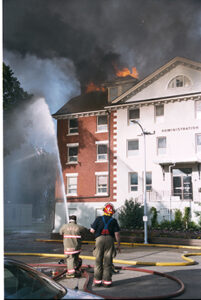
Fire at Michener Centre, June 18, 2003. Photographer Dr. Robert Lampard. Red Deer Archives, E3021.
In 2007 the province sold 16.6 acres of land on the Michener south site to the David Thompson Health Region and the Extendicare Michener Hill was built on the land along with seniors’ condos and other developments. 2021-2022 the vacant Michener north site underwent demolition and a reclamation project was started. Along with the Michener north water tower, 28 buildings were demolished after being deemed unsuitable for repurposing by Alberta Infrastructure. The City of Red Deer plans to purchase the land and integrate it into park space. The Michener south site continues to be used/occupied by the DTHR, Michener Aquatic Centre, and the Michener Curling Club, and the remaining Michener Centre Services.
Alberta Health Services 2017 site map
Red Deer Archives Records:
A Note on Restrictions:
Due to the nature of these records, many are subject to Freedom of Information and Protection of Privacy (FOIP) legislation and therefore have access restrictions around personal and medical information. Records created by staff are also often under Crown copyright restrictions. Some records will only be available for in person research, some records may not be able to be reproduced, and some records cannot be viewed at all. Please contact the Archives before your visit to learn more about the records you are seeking to access.
Fonds and collections include records from past residents (Doreen Befus), past staff (Dr. Robert Lampard, Alban James, Violet Falk), and associated organizations (Alberta Mental Health Deficiency Nurses Association, Michener Services Pastoral Care Committee). There are also related records in the City of Red Deer fonds and in the reference library.
You can learn more about these records using the Michener Centre Research Guide.
There is also a digital collection on Preservica, containing selected digitized photographs and records.
Further records are held at the provincial level, and may be accessible through the Provincial Archives of Alberta or from their government agency Alberta Health Services.
Citations:
CBC staff. “Alberta Apologizes for Forced Sterilization,” CBC News. Nov. 9,1999, https://www.cbc.ca/news/canada/alberta-apologizes-for-forced-sterilization-1.169579.
Red Deer News staff. “Alberta Ladies College,” The Red Deer News, July 16, 1913, Newspapers.com (accessed July 9, 2024).
Alberta Social Services and Community Health. Michener Centre: A History 1923-1983. Government of Alberta, 1983.
Brown, Nancy. “Population moving north at Michener Centre”. Red Deer Advocate. November 24, 1986, Newspapers.com (accessed September 18, 2024).
Red Deer Advocate staff. “Changing Institutions: Mentally Defective Children Coming to Soldiers Hospital,” The Red Deer Advocate, March 23, 1923, Newspapers.com (accessed July 10, 2024).
Red Deer News staff. “City Council Meeting,” The Red Deer News, June 28, 1916, Newspapers.com (accessed July 9, 2024).
Dawe, Michael J. “Michener Building Began as College,” Red Deer Advocate, June 11, 2007.
Dawe, Michael J. Red Deer: The Memorable City. City of Red Deer, 2013.
Fish, Myles. “Michener land has great value, but no plan for it yet.” Red Deer Advocate. April 1, 2014, Newspapers.com (accessed September 18, 2024).
Ha, Tu Thank. “Leilani Muir made history suing Alberta over forced sterilization.” Globe and Mail. March 16, 2016, https://www.theglobeandmail.com/news/alberta/woman-who-made-history-suing-alberta-over-forced-sterilization-dies/article29256421/ .
History Book Committee, History of Alberta Mental Deficiency Nurses, 1988.
Malacrida, Claudia. A Special Hell. Institutional Life in Alberta’s Eugenic Years. Toronto: University of Toronto Press, 2015.
Michelin, Lana. “Demo slated for completion this fall: Alberta Infrastructure.” Red Deer Advocate. August 3, 2022, Newspapers.com (accessed September 18, 2024).
“Michener Centre Administration Building,” HeRMIS: Heritage Resources Management Information System, Government of Alberta, accessed July 2024, https://hermis.alberta.ca/ARHP/Details..
Edmonton Bulletin staff. “Sanitarium At Red Deer Will Open Thursday,” The Edmonton Bulletin, March 14, 1918, Newspapers.com.
Red Deer Advocate staff. Tall Salvage Order.” Red Deer Advocate. April 11, 1978, Newspapers.com (accessed September 18, 2024).
Tester, L. “End of an Era,” Red Deer Advocate, July 18, 2008, https://www.eugenicsarchive.ca/timeline?id=53276110132156674b00028a
Red Deer Advocate staff. “Transferring Patients,” The Red Deer Advocate, June 29, 1923, Newspapers.com (accessed September 18, 2024).
